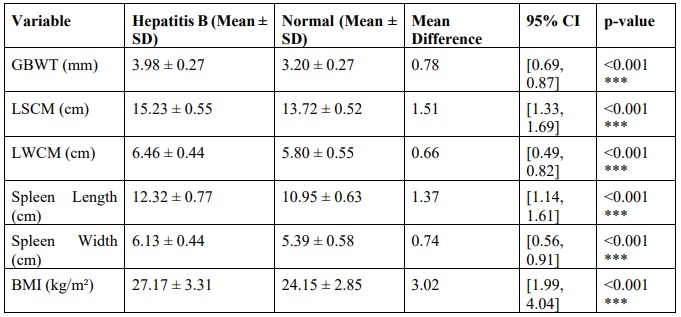SONOGRAPHIC EVALUATION OF GALL BLADDER WALL THICKNESS IN HEPATITIS B PATIENTS: A CROSS-SECTIONAL STUDY
DOI:
https://doi.org/10.71146/kjmr522Keywords:
Hepatitis B, Gall Bladder Wall Thickness, UltrasonographyAbstract
Background:
Hepatitis B virus (HBV) infection is a global health burden with known hepatic complications and potential impacts on the biliary system. Gall bladder wall thickening (GBWT), an indicator of hepatobiliary pathology, has been under-investigated in the context of chronic HBV.
Objective:
To assess and compare gall bladder wall thickness between HBV patients and healthy individuals using ultrasonography.
Methodology:
A cross-sectional study was conducted at Hayatabad Medical Complex, Peshawar, enrolling 142 participants—71 HBV-positive patients and 71 matched healthy controls. Sonographic assessments were performed using standardized protocols, and GBWT was measured. Additional parameters including liver and spleen dimensions and BMI were recorded. Data were analyzed using descriptive statistics and independent t-tests.
Results:
The mean GBWT in HBV patients was 3.98 mm (SD = 0.27), significantly higher than that of controls (3.20 mm, SD = 0.27; p < 0.05). No significant difference was observed in gall bladder length. However, HBV patients showed increased liver and spleen dimensions and higher BMI values compared to controls. These findings support the hypothesis that chronic HBV contributes to measurable anatomical changes in hepatobiliary structures.
Conclusion:
There is a significant association between chronic HBV infection and increased GBWT. Routine ultrasound evaluation of the gall bladder in HBV patients is recommended for early detection of hepatobiliary complications, facilitating timely intervention and improved disease management.
Downloads

Downloads
Published
Issue
Section
License
Copyright (c) 2025 Hayan Ullah, Iqra Saeed (Author)

This work is licensed under a Creative Commons Attribution 4.0 International License.






